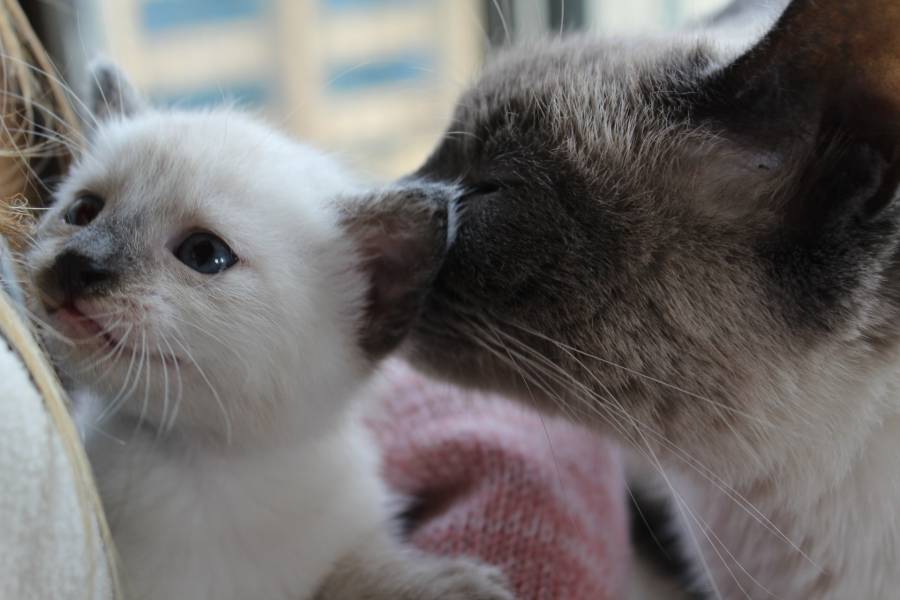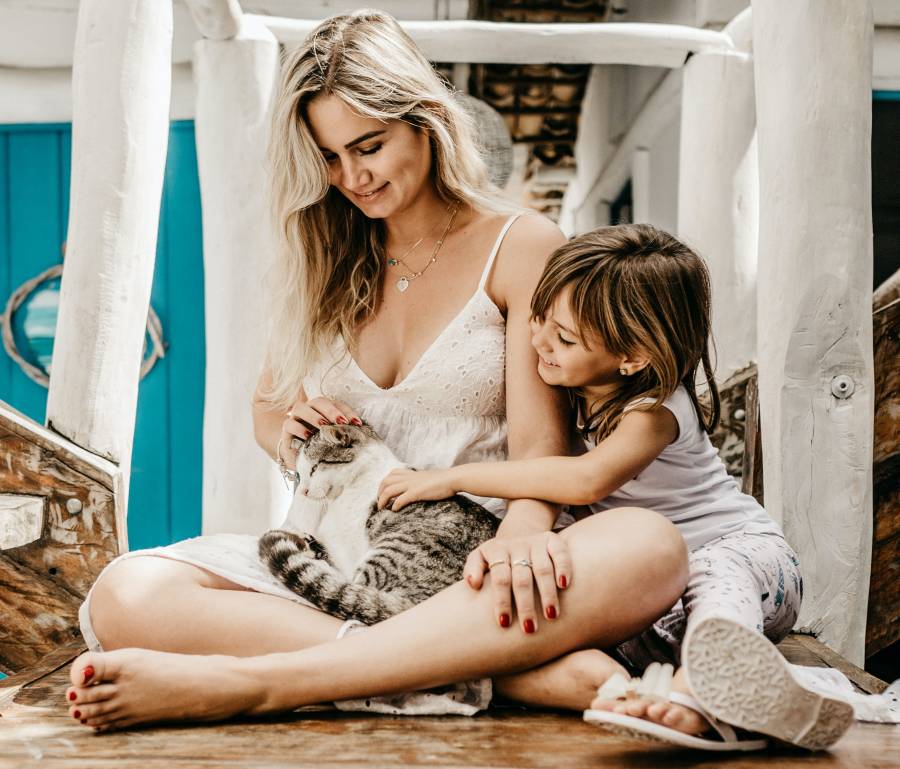Quick Navigation
Most cats have been giving birth smoothly. Still, large or deformed kittens can get stuck in the pelvis in the process of birth.
They sometimes come halfway, and sometimes they do not even get that far.

If your cat giving birth has a kitten stuck, you may need to read this article to the end to know what to do.
My Cat’s Giving Birth
Most cat owners are very familiar with various aspects of cat health care.
But there is one issue that not all cat owners will have to face – this is their cat giving birth.
In most cases, the cat owner knows that their pet is pregnant.
So they expect the birth not to come as a big surprise.
When female cats are pregnant, many things can go wrong, even if most female cats give birth without significant problems.
The mother should take care of the kittens.
By washing and nursing them, she’s bonding with her babies.
What You Need To Know
Some people rush to the vet when their pregnant cat is a little tired from walking.
Others wait too long because they fail to notice their cat’s discharge.
Or, they may not know how to cut an umbilical cord without causing profuse bleeding.
Among the dozen possible complications that may happen to your cat include:
- Infection in the womb
- Death of the fetus
- Miscarriages
- Development of a fetus outside of the womb
- Asphyxiation of a kitten right after birth
- A cat giving birth with a kitten stuck. The list goes on.
Everything comes down to your ability to spot complications, as there is a lot you can do to avoid the worst.
A visit to the veterinary hospital may not be necessary, which is good news for your cat and your budget.
Causes Of Birth Difficulties In Cats
A problematic experience is medically called dystocia – difficult birth.
It can also be classified as an obstructed birth canal (maternal) or uterine muscle dysfunction (fetal).
Every stage of labor can result in it, depending on whether the queen or the kitten is the source of the issue.
- Abnormalities of presentation
- Posture
- Position of the fetus in the womb
It can negatively affect the temporal relationship between the offspring and the maternal birth canal.
Prolonged kittening can cause your cat and its uterine muscles to become tired and ineffective. It is called uterine inertia.
Two main factors make cats susceptible to labor obstruction- dystocia such as:
- Mechanical blockage
- Uterine inertia
Mechanical Blockage
The typical kitten birth pattern is exiting the birth canal with the nose and feet first and the back next to the crown of the vagina.
However, kittens that are too big or malformed risk getting stuck in the pelvis.
They occasionally only make it halfway, and sometimes they don’t even make it that far.
An oversized kitten or a wrong placement of a kitten in the birth canal are the two main reasons for mechanical blockage.
Do not attempt to remove the kitten if your cat has one stuck inside; instead, call your veterinarian for guidance.
Uterine Inertia
Your cat (and the muscles in her uterus) could become exhausted and incapable if the kittening process is prolonged (uterine inertia).
Age, obesity, a history of dystocia, and sudden changes in their environment prior to going into labor are all factors that make a cat more susceptible to dystocia.
If the uterine muscles become too weak, labor becomes almost impossible.
The uterus cannot generate solid and effective contractions.

Uterine inertia can either be primary or secondary:
- Primary inertia manifests itself as the inability of the body to initiate synchronous uterine contractions.
- Secondary inertia is manifested by the cessation of uterine contractions due to uterine fatigue.
The latter condition sometimes occurs when labor has lasted longer than the uterine muscles can handle.
Reasons for uterine fatigue are:
- Having a huge litter
- A single, massive kitten in a tiny uterus
- Distortion of the uterus
- Excess amniotic fluid
Older cats, obese queens, and queens who have small litters of relatively oversized kittens are more likely to experience mechanical blockage and uterine inertia.
Cat breeds like Persians, which have large heads and flat faces, are more likely to experience these conditions.
Additionally, the first or last kitten’s birth is frequently a part of it.
Cats Giving Birth Has Kitten Stuck
Unfortunately, some cat owners don’t know what to do when a kitten gets stuck in their mother while trying to give birth.
Try never to panic and remember that most female cats, also known as queens, will adapt perfectly to childbirth.
They will not require you or a veterinarian.
It is wise to be vigilant and watch for excessive discomfort or a stuck kitten.
Your cat would show many symptoms if it still had kittens.
Cat will sit sideways and not be stable to allow the stuck kitten to come through the birth canal.
When a cat pants, gasps, cries or appears exhausted in vain, it becomes uncomfortable and restless.
It eventually gives up to gain enough strength for further, albeit reduced exertion. This cat needs help.
External touching around the perineum area below the tail indicates whether a kitten has already crossed the pelvis.
A nose or paw and tail view on the vulva indicates that the kitten is about to give birth.
If no progress is being made and the kitten is visible, your responsibility is to provide immediate help.
The vet may not arrive on time for that kitten unless the vet lives on the premises.
My Cat Giving Birth Has Kitten Stuck Inside Her. What Should I Do?
- After each kitten is born, the mother must deliver a placenta. Usually, she will eat some or all of her placentas. Try to count them when they come out and make sure there is a placenta for each kitten. If there are more kittens than placentas, one must have failed to come out.
- You can help your cat by helping her feel around the bulge and gently and continuously pushing on one side of the kitten’s form. It is for it to turn around into the canal.
- Never force it in any direction. It is normal if you notice your cat is still laboring with a kitten stuck inside her. When you notice it has stopped laboring and there is still a giant clump of other kittens left, you should take her to the veterinarian. Do this right away to get her labor done.
- An undelivered placenta can make a cat sick, as a kitten shouldn’t spend more than ten minutes in the birth canal. So, if you can’t communicate with your vet and your cat doesn’t bite through the umbilical cord, tying it off with dental floss and cutting it yourself may be the only option.
- If you see your cat giving birth and has a kitten stuck inside her, you can try holding its hips or shoulders with a clean towel and gently pulling it.
If your cat does not give birth to its last kitten, it will likely develop a fever, and the kitten could die.
Once you don’t feel any movement, the kitten may be dead.
Conclusion
If something goes wrong during labor, having the right skills can save a kitten’s life, especially if a kitten becomes stuck while your cat is giving birth.
Yes, you can acquire these skills. Remember, time is very crucial in most medical crises.
So, if you have a pregnant cat, educating yourself is just as important.
Take the time to read about cat pregnancies. Talk to a professional breeder.
If you discover your cat is pregnant, seek advice from your veterinarian.
Don’t sit back and think all will be fine.
You can save yourself and your cat a devastating experience with time and effort.

Zoey is a long-time pet owner and animal rights advocate, a vital part of Purrfect n’ Pawesome. She shares her unique experiences and learnings with her readers to enhance their understanding of pet behavior and nutrition. Along with being an active pet writer, she volunteers at multiple animal shelters, rescue centres with some bespokenly awesome pets.
Zoey has a lot to share when raising the pets and spending life being their true friends. She has a quite pampered Persian cat and a Ragdoll, whom she loves the most. Readout her blogs to know more about being a responsible parent to your beloved pets.
“I love to be around cats and dogs; that’s my passion and my trick to get away from all the negativity and soaking in unconditional love and affection. Being attached to this platform gives me the reason to be vocal about pet love, care, and nurturing. Although I am not an expert or veterinarian by any means, I have a lot of experience and learnings to share with my fellow readers.”






